
With March being Endometriosis Awareness Month, we are helping raise awareness for this condition that affects 1 in 10 women worldwide, has no known cause and unfortunately, no cure. Endometriosis is a painful, chronic condition affecting more than 5 million women in the U.S. alone. It occurs when endometrium tissue, that normally lines the insides of your uterus, grows outsides your uterus. Endometriosis most commonly involves a woman’s pelvic organs, where the displaced endometrial tissue will break down and bleed like it would with a normal period, except it is trapped and has no way to exit the body. Cysts and inflamed tissue forms, and can cause severe pain and excessive bleeding, along with other symptoms. Endometriosis pain can be so severe and debilitating that women may not be able to carry out their typical daily activities.
Many women suffering from endometriosis also suffer from infertility, although it doesn’t directly cause infertility. According to the American Society for Reproductive Medicine, endometriosis can be found in up to 50% of infertile women and patients with endometriosis suffer from infertility in about 30 to 50% of cases. Laparoscopic surgical options are used to diagnose, repair or remove tissue, and other hormonal treatments can lessen or decrease the prevalence of endometriosis. And while pregnancy can actually help relieve some the symptoms of endometriosis, it is not a cure.
It was first suspected that I suffer from endometriosis in high school, due to the very painful cramps I experienced around and during my period. Those got worse in college, and finally after graduate school I had laparoscopic surgery that officially diagnosed me and removed some of the damaged tissue. Around 30 years of age, my treatment continued with hormonal treatments that basically sent me into early menopause for six months. Ultimately, I decided to stop the treatment early as I wasn’t sure the side-effects outweighed my symptoms.
I always knew my endometriosis might impact my fertility, even before my official diagnosis. I wanted children in the future, so knowing that I could have fertility issues made me start to think about adoption at a very early age. I knew that pregnancy might not come easy to me, and it actually helped open my eyes to an alternative way to build my family. It also didn’t hurt that my closest aunt also had endometriosis (that eventually led to a hysterectomy) and she had also adopted my cousin, Andrew, who is like a brother to me. Through my extended family, I had the benefit of exposure to families created by domestic and international adoption, and my endometriosis diagnosis just nudged me a little more in that same direction.
When I dated people seriously, I always brought up the fact that I might not be able to have children naturally, and may need assistance getting pregnant or to turn to adoption to complete my family. I was surprised by the reaction. I was told by more than one serious boyfriend that they weren’t sure they could love an adopted child. Those surprising statements always affected my relationships, and at least once was a factor in ending the relationship. That’s why I brought up my endometriosis and my desire to adopt early-on with my now-husband, Ray. Not only was he not scared off by the fact that I was bringing up such a heavy topic on our second date, he was the first person to be excited about adoption as a way to grow a family. He told me of his close relationship with his oldest niece who is also adopted, and was interested to hear about all the ways adoption had touched me and my family.
When Ray and I got married, we always knew adoption would be part of our plan, we just weren’t sure if it would lead to our first child, or a later one. We decided to start with one round of in vitro fertilization and then get our adoption journey going in case that didn’t work, or for a later child. The day we learned our first round of IVF failed without much explanation, we hired our adoption consultant and called a home study agency to begin our journey. Our fertility doctor convinced us to try another round of IVF and I remember doing fertility shots at the same time I was filling out the voluminous home study paperwork. When our second round of IVF failed too, it reinforced the idea that adoption was the plan for our family. Never did I expect that a higher power was just telling me that a sweet baby girl named Cora needed to make her way into our hearts, minds and arms first, before taking home our daughter Raelyn through a surprise pregnancy (with absolutely no fertility treatments!) 8 months later. I truly believe this sequence of events unfolded because these two girls were meant to be together – destined to be sisters. Now that the girls are 2 and 3, I still suffer from many of the symptoms of endometriosis, but I also count it as one of the reasons I opened my heart and mind to adoption, and to my two beautiful daughters!
For more information about Endometriosis, visit endometriosis.org.

With March being Endometriosis Awareness Month, we are helping raise awareness for this condition that affects 1 in 10 women worldwide, has no known cause and unfortunately, no cure. Endometriosis is a painful, chronic condition affecting more than 5 million women in the U.S. alone. It occurs when endometrium tissue, that normally lines the insides of your uterus, grows outsides your uterus. Endometriosis most commonly involves a woman’s pelvic organs, where the displaced endometrial tissue will break down and bleed like it would with a normal period, except it is trapped and has no way to exit the body. Cysts and inflamed tissue forms, and can cause severe pain and excessive bleeding, along with other symptoms. Endometriosis pain can be so severe and debilitating that women may not be able to carry out their typical daily activities.
Many women suffering from endometriosis also suffer from infertility, although it doesn’t directly cause infertility. According to the American Society for Reproductive Medicine, endometriosis can be found in up to 50% of infertile women and patients with endometriosis suffer from infertility in about 30 to 50% of cases. Laparoscopic surgical options are used to diagnose, repair or remove tissue, and other hormonal treatments can lessen or decrease the prevalence of endometriosis. And while pregnancy can actually help relieve some the symptoms of endometriosis, it is not a cure.
It was first suspected that I suffer from endometriosis in high school, due to the very painful cramps I experienced around and during my period. Those got worse in college, and finally after graduate school I had laparoscopic surgery that officially diagnosed me and removed some of the damaged tissue. Around 30 years of age, my treatment continued with hormonal treatments that basically sent me into early menopause for six months. Ultimately, I decided to stop the treatment early as I wasn’t sure the side-effects outweighed my symptoms.
I always knew my endometriosis might impact my fertility, even before my official diagnosis. I wanted children in the future, so knowing that I could have fertility issues made me start to think about adoption at a very early age. I knew that pregnancy might not come easy to me, and it actually helped open my eyes to an alternative way to build my family. It also didn’t hurt that my closest aunt also had endometriosis (that eventually led to a hysterectomy) and she had also adopted my cousin, Andrew, who is like a brother to me. Through my extended family, I had the benefit of exposure to families created by domestic and international adoption, and my endometriosis diagnosis just nudged me a little more in that same direction.
When I dated people seriously, I always brought up the fact that I might not be able to have children naturally, and may need assistance getting pregnant or to turn to adoption to complete my family. I was surprised by the reaction. I was told by more than one serious boyfriend that they weren’t sure they could love an adopted child. Those surprising statements always affected my relationships, and at least once was a factor in ending the relationship. That’s why I brought up my endometriosis and my desire to adopt early-on with my now-husband, Ray. Not only was he not scared off by the fact that I was bringing up such a heavy topic on our second date, he was the first person to be excited about adoption as a way to grow a family. He told me of his close relationship with his oldest niece who is also adopted, and was interested to hear about all the ways adoption had touched me and my family.
When Ray and I got married, we always knew adoption would be part of our plan, we just weren’t sure if it would lead to our first child, or a later one. We decided to start with one round of in vitro fertilization and then get our adoption journey going in case that didn’t work, or for a later child. The day we learned our first round of IVF failed without much explanation, we hired our adoption consultant and called a home study agency to begin our journey. Our fertility doctor convinced us to try another round of IVF and I remember doing fertility shots at the same time I was filling out the voluminous home study paperwork. When our second round of IVF failed too, it reinforced the idea that adoption was the plan for our family. Never did I expect that a higher power was just telling me that a sweet baby girl named Cora needed to make her way into our hearts, minds and arms first, before taking home our daughter Raelyn through a surprise pregnancy (with absolutely no fertility treatments!) 8 months later. I truly believe this sequence of events unfolded because these two girls were meant to be together – destined to be sisters. Now that the girls are 2 and 3, I still suffer from many of the symptoms of endometriosis, but I also count it as one of the reasons I opened my heart and mind to adoption, and to my two beautiful daughters!
For more information about Endometriosis, visit endometriosis.org.



